The Chinese character 伽 - Chinese-German Dictionary HanDeDict |
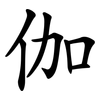
|
| pronunciation (Pinyin): | | |
| pronunciation (Cantonese): | | |
| historical pronunciation (Tang): | | ghia |
| |
| Kangxi radical: | | |
| ancient variant of: | | |
|
|
Styles of writing
|

regular script
|
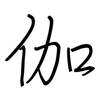
regular script (using a pen)
|
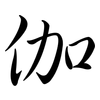
semi-cursive script
|
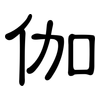
clerical script
|
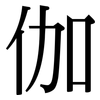
serif (Songti/Mingti)
|
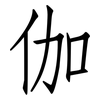
Fangsongti
|
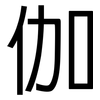
sans serif
|
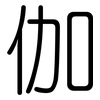
rounded
|
Meaning of 伽 when used as a word
|
The following entry has not been verified:
|
|
|
|
|
|
|
Further example words that contain the character 伽
|
|
|
|
|
The following entries have not been verified:
|
|
|
|
|
|
|
|
|
|
|
|
|
|
|
|
|
|
|
|
|
|
|
|
|
|
|
|
|
|
|
|
|
|
|
|
|
|
|
We say thank you...
|
The Cantonese pronunciation(s) for this character are presented using jyutping romanization. Sources include the Unihan database and the Jyutping phrase box from the Linguistic Society of Hong Kong. The copyright of the Jyutping phrase box belongs to the Linguistic Society of Hong Kong. We would like to thank the Jyutping Group of the Linguistic Society of Hong Kong for permission to use the electronic file in our research and product development. |
|